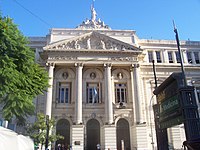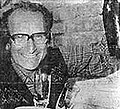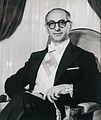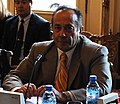User:Andresuba/University of Buenos Aires
Universidad de Buenos Aires | |
 Seal of the University of Buenos Aires | |
| Motto | Argentum Virtus Robur et Studium (Latin) |
|---|---|
Motto in English | Argentine virtue is strength and study |
| Type | Public |
| Established | 12 August 1821 |
| Budget | 364 690 000 US dollars (2009) [1] |
| Rector | Rubén E. Hallú |
Academic staff | 28 943 (2004) [2] |
| Students | 311 175 (2004) [3] |
| Undergraduates | 297 639 (2004) |
| Postgraduates | 13 536 (2004) |
| Location | , |
| Campus | Urban |
| Website | www.uba.ar |
The University of Buenos Aires (UBA) (Spanish: Universidad de Buenos Aires), founded on August 12, 1821 in the City of Buenos Aires, is the largest university in Argentina and one of the most prestigious of the Americas.
As the rest of the Argentine national universities, it depends finantially of the National State, but it's autonomous, free, lay and gratuitous. For being autonomous, it has its own government system, formed since the University Reform in 1918 by representatives of professors, students and alumni. The academic freedom promotes that there is more than a cathedra that dictates each subject. The academic staff is selected by contest and evaluation before juries.
Undergraduate teaching, excluding a short period between 1982 and 1983, has been completely costless since 1949, year in which the ordinance 29.337 was issued and through which the president Juan Domingo Perón deleted the imposotion of current tuition fees so far.
The admission to the university is unrestricted, although since 1985 the first year of almost all undergraduate courses is the Common Basic Cycle (CBC), which must be approved in order to enter the corresponding faculty. The University of Buenos Aires is composed by 13 faculties, the Common Basic Cycle, the Buenos Aires National School, the Carlos Pellegrini High School of Commerce, the Free Institute of Secondary Education, the Professional Technical School of Agriculture and Agri-Food Production, 8 regional university centers, the Ricardo Rojas Cultural Center, the Buenos Aires University Press (EUDEBA), the Cosmos Cinema, 16 museums and 5 care units.
In 2006, it counts with an offert of 72 undergraduate courses and 28 490 professors. Around a 30% of the national scientific investigation is carried out by this institution. Four out of five Nobel laureates have been students or teachers in this university.
Composition of the university
[edit]





- Faculty of Agronomy
- Faculty of Architecture, Design and Urbanism
- Faculty of Economic Sciences
- Faculty of Exact and Natural Sciences
- Faculty of Social Sciences
- Faculty of Veterinary Sciences
- Faculty of Law
- Faculty of Biochemistry and Pharmacy
- Faculty of Philosophy
- Faculty of Engineering
- Faculty of Medicine
- Faculty of Dentistry
- Faculty of Psychology
Hospital network
[edit]- Institute of Medical Research "Alfredo Lanari"
- Institute of Oncology "Ángel Roffo"
- Institute of Phthisioneumonology "Raúl F. Vacarezza"
- "José de San Martín" Clinical Hospital
- School Hospital of the Faculty of Veterinary Sciences
- University Odontologic Hospital
Extension
[edit]The university counts with 16 museums of different disciplines, such as veterinary anatomy, pharmacy, pathology, mineralogy, ethnography, mathematics, pharma-botanic, history, sciences, psychology, archeology, etc.
Campus
[edit]The University of Buenos Aires has not a per se campus that compounds all its faculties, but it has two main terrains that gather most of its academic units:
- Buenos Aires University City: located in the district of Núñez, it is divided into 3 buildings in which all courses corresponding to the faculties of Architecture, Design and Urbanism and Exact and Natural Sciences are taught. It is also one of the 15 branches of the CBC.
- Regional Paternal University Center: it's located in the limits of La Paternal and Agronomía. Here the faculties of Agronomy and Veteriary Sciences are found. Here the CBC courses are also taught.
Government system
[edit]The current government system of the University of Buenos Aires is tripartite, inspired in the University Reform in 1918. It's formed by the Superior Council and the Rector, who presides it. The Superior Council consists of the deans of each faculty and of representatives of professors, alumni and students.
Thus, each faculty has a govenrment that consists of a dean and a board, integrated by 8 representatives of teachers, 4 of alumni and 4 of students; all of them elected by a compulsory and direct vote.
Prominent alumni
[edit]Nobel laureates
[edit]Four out of five Argentine Nobel Laureates have studied or taught at the University of Buenos Aires.
- Dr. Carlos Saavedra Lamas
 : Nobel Peace Prize 1936; professor at the Faculty of Law.
: Nobel Peace Prize 1936; professor at the Faculty of Law. - Dr. Bernardo Houssay
 : Nobel Prize in Physiology or Medicine 1947; professor at the Faculty of Medicine.
: Nobel Prize in Physiology or Medicine 1947; professor at the Faculty of Medicine. - Dr. Luis Federico Leloir
 : Nobel Prize in Chemistry 1970; ex professor at the Faculty of Medicine and the Faculty of Exact and Natural Sciences.
: Nobel Prize in Chemistry 1970; ex professor at the Faculty of Medicine and the Faculty of Exact and Natural Sciences. - Dr. César Milstein
 : Nobel Prize in Physiology or Medicine 1984; ex professor at the Faculty of Medicine and graduated at the Faculty of Exact and Natural Sciences.
: Nobel Prize in Physiology or Medicine 1984; ex professor at the Faculty of Medicine and graduated at the Faculty of Exact and Natural Sciences.
Presidents of Argentina
[edit]Many Argentinian presidents studied at this unviersiy, their names and professions are shown in the following list.
- Carlos Pellegrini, lawyer.
- Luis Sáenz Peña, lawyer.
- Manuel Quintana, lawyer.
- Roque Sáenz Peña, lawyer.
- Victorino de la Plaza, lawyer.
- Hipólito Yrigoyen, lawyer.
- Marcelo Torcuato de Alvear, lawyer.
- Agustín Pedro Justo, civil engineer.
- Roberto Marcelino Ortiz, lawyer.
- Ramón S. Castillo, lawyer.
- Arturo Frondizi, lawyer.
- Arturo Umberto Illia, physician.
- Raúl Alfonsín, lawyer.
- Adolfo Rodríguez Saá, lawyer.
- Eduardo Duhalde, lawyer.
Gallery
[edit]-
Carlos Saavedra Lamas, Nobel Peace Prize, 1936.
-
Bernardo Houssay, Nobel Prize in Medicine, 1947.
-
Luis Federico Leloir, Nobel Prize in Chemistry, 1970.
-
César Milstein, Nobel Prize in Medicine, 1984.
-
Carlos Pellegrini.
-
Luis Sánez Peña.
-
Manuel Quintana.
-
Victorino de la Plaza.
-
Ramón S. Castillo.
-
Arturo Frondizi.
-
Arturo Umberto Illia.
-
Adolfo Rodríguez Saá.
-
Eduardo Duhalde.













